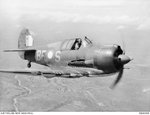Frantish
Airman 1st Class
C-47A "That's All-Brother"equipment search challenge, origin of flame dampeners / suppressors
The one item on TA-B that is unknown by us is the Flame Dampeners (aka Suppressors), so I am asking across several boards (first with the English ones).
Looking at film of the aircraft it shows some kind of Flame Suppressors / Dampeners under the wings.
Since the para drops was at night it is obvious a necessity.
However the USAAF rarely did night missions so that device is somewhat unique.
It is my belief the USAAF went to RAF colleagues and "borrowed" some off a Halifax or Beaufighter.
I am asking this bunch of hanger bums to divulge what rumor they have and post here.
Video of That's All --- Brother is here, one can see the longer exhaust tubes as it takes off.
View: https://www.youtube.com/watch?v=IS5bKV9I4mo
Still of film (ignore yellow arrow, points to Radar dome. Instead look around gear struts):

It is not difficult to find C-47's with it installed, but the images tend to be grainy and being under the wing dark! Something with excellent detail is needed.

And a picture of another C-47 with suppressors.

Some existing RAF samples (I call them RASP Type because this reminds me of the wood tool).
Halifax

Beaufighter

On a side note:
QUESTION: does the RAF type also reduce engine exhaust noise??
On a side note , picture of crew was found with TA-B, but the suppressor was NOT installed at this time.

THANKS FOR HELPING!
The one item on TA-B that is unknown by us is the Flame Dampeners (aka Suppressors), so I am asking across several boards (first with the English ones).
Looking at film of the aircraft it shows some kind of Flame Suppressors / Dampeners under the wings.
Since the para drops was at night it is obvious a necessity.
However the USAAF rarely did night missions so that device is somewhat unique.
It is my belief the USAAF went to RAF colleagues and "borrowed" some off a Halifax or Beaufighter.
I am asking this bunch of hanger bums to divulge what rumor they have and post here.
Video of That's All --- Brother is here, one can see the longer exhaust tubes as it takes off.
View: https://www.youtube.com/watch?v=IS5bKV9I4mo
Still of film (ignore yellow arrow, points to Radar dome. Instead look around gear struts):
It is not difficult to find C-47's with it installed, but the images tend to be grainy and being under the wing dark! Something with excellent detail is needed.
And a picture of another C-47 with suppressors.
Some existing RAF samples (I call them RASP Type because this reminds me of the wood tool).
Halifax
Beaufighter
On a side note:
QUESTION: does the RAF type also reduce engine exhaust noise??
On a side note , picture of crew was found with TA-B, but the suppressor was NOT installed at this time.

THANKS FOR HELPING!
Last edited:

